
A view from the abandoned pier on my daily walk along the levee in my new neighborhood of the Lower 9th Ward, New Orleans, LA. The “Central Business District (CBD)” of New Orleans can be seen beyond the Mississippi. 09.07.2024
FIELD REPORT
A VIEW OF THE WORLD FROM THE LOWER NINTH WARD
Its one of those purgatory mornings, gray, even light making everything flat, crisp, melancholy. Wisps of fog cling to the low inland slope of the levee, the crunch of gravel underfoot the only sound other than the occasional sloshing of the waves on the banks, wakes from the passing barges on the Mississippi. Sometimes the city skyline over there across the river looks sort of heroic, grand even, like a bygone, adolescent New York viewed from some longshoreman’s boat out in the Meadowlands of New Jersey (one imagines). But today it looks sort of pathetic, frail, small, not a “real” downtown— and wholly inappropriate on this flat, wet, horizon. I’m grateful to live here, in the part of the lower 9th that borders the river; one of the few places in the city you can maybe forge a real connection with the water, get a glimpse, a ghost image, really, of what the delta might have been like in its early days.
Because I am downriver from the port, and because of the proximity to the Industrial Canal that connects the River to Lake Pontchartrain (and cuts me off from the rest of the city) I am ensured regular traffic of staggeringly large boats. This, too, feels like a view rarely given which I feel lucky to receive; a peek behind the curtain of the constant churn of global petrocapital trade. Seeing these whales of boats, like whole cities crushing towards you, blotting out the sky, materializes just how much damn stuff we collectively consume daily.
Sometimes men are fishing off the abandoned pier, their coolers full of fat, long, possibly-polluted catfish. I worry about the pollution, heavy metals and the like (what with this being a long-industrialized waterway and at the end of a massive watershed, the collection of half of America’s waste water and runoff), especially because I assume I’ve eaten these catfish in my poboys already. In spite of, or perhaps because of, this paranoia I think I’ll get my fishing pole set up (Thanks again, Jonathan!) and join them one morning as I pass. Again, to materialize the reality of consumption, of eating fish. This is something new for me, following nine years of vegetarianism, and I want to catch and prepare some with my own hands. Today the pier is silent, wind-swept, with only faint bloodstains marking where the fisherman usually stand. The horrors of our post-ecological world: to fear the very river which gives me my drinking water, to see fresh fish not as bounty but as potential poison. And not just here, but everywhere: everything is both vital to life and a hidden, slow death. You cannot avoid the plastics. A biological rejection at the cellular level of our way of life. And so we joke about it.

One of the pair of “Steamboat Houses” found along the banks of the Mississippi in my new neighborhood, also known as Holy Cross. 09.07.2024
On that topic (i.e. jokes about the horrors of contemporary life) I’ve been thinking maybe I should re-read White Noise. Some enterprising romantic has hung a nice, sturdy swing from the Channel marker, a large, two-story metal structure with a bright orange triangular sign offering the number 2 for the passing boats. It is perfectly oriented for sunset, plus the buildings of the CBD offer protection from the harsh red ball of sun, so you can enjoy the changing gradients of the firmament without harm to your eyes (as much). Here is another instance of beauty and the unknown ills of the world—like a moth to the flame. I remember that from White Noise; the potent symbolism of these otherworldly sunsets after “”The Airborne Toxic Event,” which is why maybe I was thinking of it as I walk to this, my new sunset spot. It deals with invisible perils.
I direct my attention, most of the time, not to the modern mass of buildings but to the subtle hint of the French Quarter, the spires of St. Louis Cathedral visible if you focus, and pretend I’m standing here before all this; before the channelization of the Mississippi, before the tall buildings, before the 1,770+ active oil platforms and web of associated pipelines out in the Gulf. This sort of intentional myopia is fun (and certainly vital for tourism in New Orleans), but the ugly truths of the region have their own insidious draw, aesthetically, and are a significant part of the reason I moved here. And so much of my exploration of this place since moving four months ago has been informed by this pendulum swing between massive infrastructures and quotidian beauty: the sublime power of the Surge Barrier on Lake Borgne, the mystery and humanness of finding some sort of spiritual offering left on the levee on my walk.
I believe that New Orleans is a place in which vital questions about the future of architecture, ecology, and governance might be asked, and with humility, attempted to answer. It is a place of both singularity— an urban island amid fecund bayous and ghost cypress stands— and incredible diversity; a roiling pot of long-held cultural traditions, emergent cultures, changing demographics. New Orleans is a city of contradictions, like a myth from Invisible Cities. It is terra firma where none should exist; a modern city in an alluvial delta constantly battling to remain (as anyone familiar with its potholes will attest). It is both a backwater town and an international destination. A place of shared cultures yet intense segregation. Its built environment ranges from quaint shotguns and Creole cottages to massive infrastructures like levees and surge barriers. It is simultaneously not recognizably American and quintessentially so.
Engaging with the built environment here means engaging with obvious challenges—flood resilience, hurricane preparedness, historical context—but also envisioning how to live differently in the face of climate change and how our lives will evolve accordingly. I could go on about why I chose to move here, and why I am grateful to call it my home, but I’ll just say this: Amid increasingly homogenized global cities, New Orleans remains distinctly its own. And so these two thick chains and a plank wood, a simple gift to the neighborhood, warms my heart each time, childlike, I launch into the air. The swing reminds me of the joy I found on my first visit to New Orleans, some 6 years ago, and reminds me why I am here today: beyond all this positioning, I just love it here.
RECOMMENDED ENCOUNTER
WATCHING FLOATING PLANTS

Location marked by a star is the very end of the former Dump at the end of Florida Ave. where I found the ruins of an old dock and hang-out/ hunting camp and sat and watched floating plants for a while.
Earth is a place where you can still lose things. But its becoming increasingly less likely, and that is something I am concerned about. I’ve been revisiting James C. Scott’s Seeing Like a State. The nutshell summary is that statecraft is integrally tied to the knowability of people, and thereby taxation and control of them, which historically has been achieved through sedentary lifestyles. Basically, Scott argues that farmers are easier to tax than nomadic peoples. Seems simple, but when you apply the logic to more complex societies like our own you see it everywhere.
What I’m trying to get at, I guess, is that I fear this same “knowability” mapped onto the physical surface of the Earth. How fantastic and strange that we can see an entire image of the world, and zoom in to any part of it, with a few clicks on our phone or laptop. Google Earth/ Google Maps has radically changed our perception of the world, I’d argue, and will only continue to do so with advances in things like LiDAR scanning and AI analysis of satellite imagery.
Sedentarianism will no longer be this vital force of state power. Indeed, this is kind of the whole premise behind Starlink and recent trends in “Digital Nomadism”: to have a fully connected world. Which sounds radical, freeing. But in practice, at least for me, results in further destabilization of community producing a further radically individualized (and thereby capitalistically efficient and profitable) existence. To be able to live a neoliberal capitalist lifestyle anywhere on Earth’s surface isn’t freedom, its destruction through homogeny. This is actually one thread in a larger question about how we perceive the Earth which I am currently trying to write a book about. So, I’d love to discuss more if anyone has thoughts on all this. (I told myself I’d write a book before I turn 30, which happens on May the 19th, giving me exactly 132 days. Hold me to it!)

All to say, I was thinking about movement and how it relates to governance and our understanding of the world when I was sitting at the edge of a former city dump, a huge, abandoned peninsula of land sticking out into what remains of Bayou Bienvenue, and I noticed these clumps of water hyacinths (Pontederia crassipes). Brought to North America from their native South America as an ornamental, it is now a particularly competitive invasive, notoriously hard to remove and fast to reproduce via cloning through runners. A la Anna Tsing, what might this tenacious plant teach us about nomadism and fecundity?
I sat for a long time, risking walking back in the dark with the wild pigs (I saw many rooting spots on the walk out), watching and photographing these moving plants, which, through their movement, evade some level of qualification.
 Mapping fails when applied to even just a few minutes of this floating plants passing by. There are too many of them, their movements too constant. They travel in packs.
Mapping fails when applied to even just a few minutes of this floating plants passing by. There are too many of them, their movements too constant. They travel in packs.WORKS IN PROGRESS ADMINISTRATION
ST. JEROME AND THE QUEST FOR HABITABLE FURNITURE

I’m looking to make myself a desk. Obviously, this is an overcomplicated undertaking for a designer. I’ve been looking at paintings of St. Jerome lately for inspiration. Part of the canonical representation of this particularly studious saint, besides a lion, is a book-strewn desk. I think it must have been a seductive subject for artists of the Renaissance. It gives a moment for them, still within the framework of religious iconography in which many were required to operate, to reflect on their very practice as artists. An atelier, a study, a desk, a studio, a room of one’s own. I love to compare different versions and imagine the artists approaching it as an exercise in creating the Platonian desk, their own perfect setup. The Barbie Dream House of a desk. I’m already running longwinded, here, so I won’t muse further on it. I’ll just share some of my favs:

Durer, 1514

DHendrik van Steenwijck the Younger, 1624

Antonello da Messina, 1474
I’ll also ask that if any of this sort of “part-room, part desk” sort of furniture comes to mind I’d be so grateful for recommendations. I’m trying to share W.I.P. work and early thoughts more in this newsletter because I think its fruitful ground for collaboration! There’s definitely some sort of project brewing, here.
Commission me to build you an authentic replica of the desk portrayed in Antonello da Messina’s version of the painting! This would be like my dream design-build job rn lol. I’ve already started 3d modeling a speculative version of it (WIP below).

POETS ANONYMOUS
A COLLABORATIVE POEM
by C.A., H.T., M.M., and Anon
The heady scent of flowers too ephemeral to name,
the mess I left for someone else,
the tiny, sweaty forehead nestled in the crook of my arm
balanced so delicately that I can’t reach
my room temperature, mediocre coffee
tapping nerves,
low humming beats, the bumps on the road heading north I-5
an oncoming storm, rain falling, the wood pecker in my brain,
Squinting and turning to face the breeze and sunbeams,
the manta rays breech for joy, obviously.
The above being the collaborative poem, submitted in parts by readers from my call in the last issue of fieldnotes. That you all so much; it was lovely to hear from each of you and catch a glimmer of your life.
Perhaps we should do another one? I am interested in how our seemingly disparate lives can find cohesive rhythms side by side like this. And a big part of the reason I started an e-newsletter was to connect with friends in a more intimate, real way than social media typically offers, so making (potentially bad) poems together seems perfect. Perhaps this time it could be that anyone interested submits a self-contained (rhyming or not) couplet (i.e. two lines of verse)? Which would then assemble, as feels most fitting, into a longer collective poem. Here’s a link to submit if you feel moved to.
ENDORSEMENTS
READING, EATING, LISTENING
Reading
I am currently re-reading To The Lighthouse by Virginia Woolf. When I first read it, I was 23, and I recall the beauty of the writing coming through, but feeling ambivalent about the broader themes of the book. I feel like what I picked up on was the 19th century gentle society and read it in a sort of straight-ahead (boring) way. But it is really quite an experimental work musing on society, feminism, and existential issues; honestly blowing my mind right now. I think age has brought me to a place I can really value the book’s themes— time, the unknowability of others, the inner-narratives, our own peculiar distortions of time and space which guide us all. There’s a section I remember in which time’s degradation on a long-shuttered house is described and mused upon which I’m really looking forward to revisiting (as you know, architecture and all, I think a lot about the poetics of the built environment).
On deck is Ulysses, another book published in the 1920s which is particularly attuned to time. I’ve been telling myself I’d read this (and moving with a chunky copy) for years. If you’re at all interested in reading along as shared accountability, give a shout.
Eating
Those not local to New Orleans may be surprised to hear that, alongside the multitude of Cajun classics, the city has fantastic Vietnamese food. After the Vietnam War, many of the United States’ South Vietnamese allies immigrated to the U.S. and a large number found a new home, and new market for french bread, in New Orleans. (In part thanks to Catholic Charities and the shared french-tinged, Catholic heritage of both Vietnam and Louisiana. So much to reflect on here in terms of shared and divergent cultural identity, colonialism, globalism…) Dong Phuong Bakery is the most famous of the many Vietnamese restaurants in the area, in particular for their version of King Cake. I tried it (not the King Cake, though it is now of the season!) for the first time a couple days ago after a visit to Bayou Savage. They have a vegetarian “beef bulgogi” Bánh mì that was so damn good, and for $6.50 no less! Also really enjoyed trying the “Yuca Silkworms” which were like gummy worms but really soft and mild tasting, and made of mung beans and Yuca powder.
Listening
Been playing the album “Send Flowers” by State Champion a good bit this week. Really great lyrics, delivered in like a channeling of David Berman (Silver Jews) from the spirit realm.
Also, I finally got around to listening to my housemate Duncan’s first record and I’m so upset I waited! Really fantastic: funky, complex, fun. His favorite artist is Prince, which definitely comes through in a great way. The production rocks, lots of cool 80s synth sounds, funky guitar pops, even a smooth sax solo. It is called “Accelerator” by The Convenience.
PHOTOLOG
NEW ORLEANS & MARYLAND AUG ‘24 - JAN ‘25

Most photos I will feature in this section are from walks, but this first one is out my car window on my drive from Los Angeles to New Orleans back in August. A first glimpse of some cypress swamps in Texas. I’m looking at getting a sea kayak, which will allow me to really put in some nautical miles exploring this ecosystem and take overnight kayak camping trips.
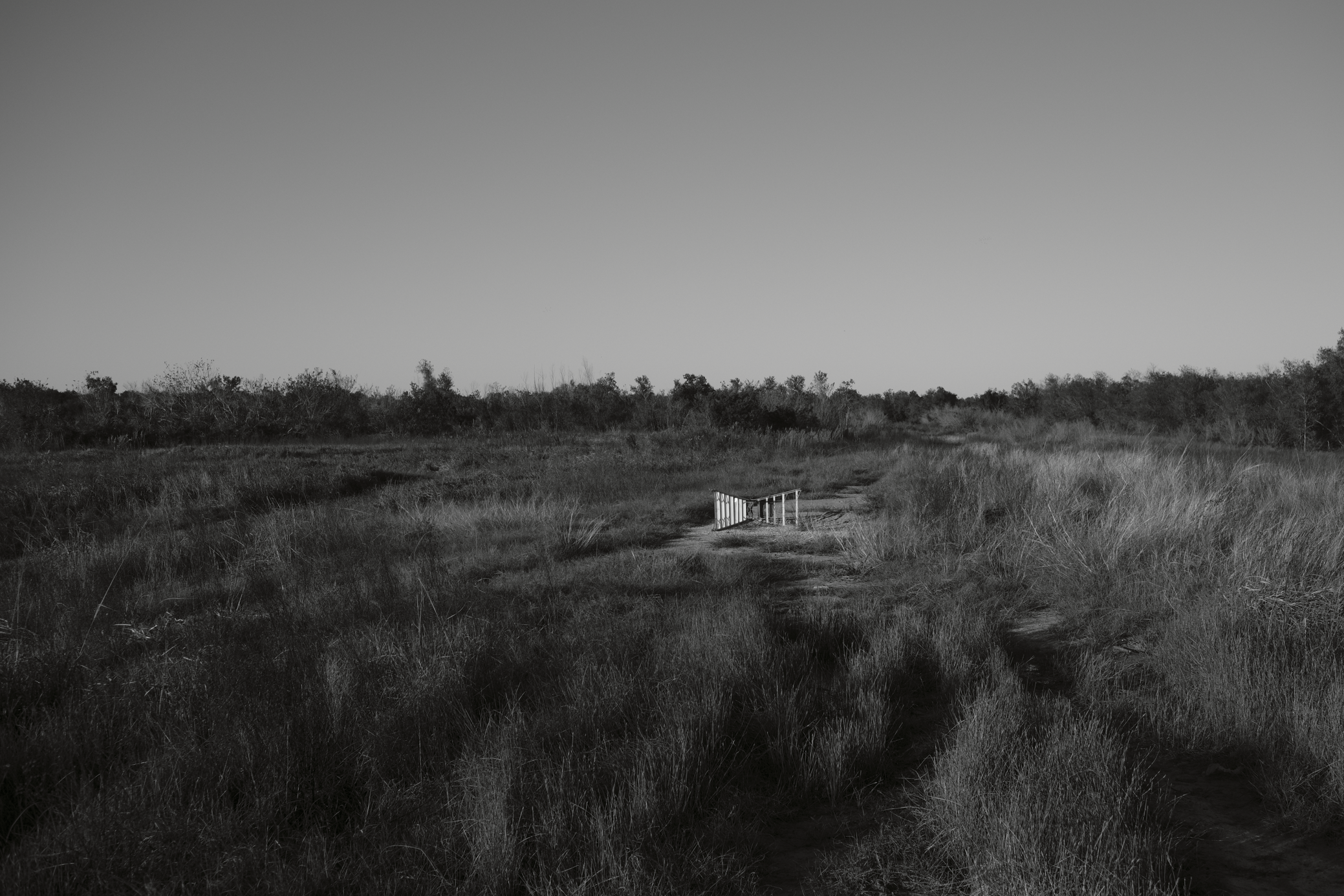
This ladder out on the stark landscape of the former city dump felt like a perfect readymade found sculpture, especially at this angle

Chris shucks an Oyster while Jonathan goes for a piece of fried Red Drum that he had caught in the Chesapeake earlier this year. Four of us put down nearly a bushel of Chesapeake and Chincoteague oysters on Thanksgiving eve. Felt really restoring and revitalized my connection with the Tidewater, which I miss dearly.
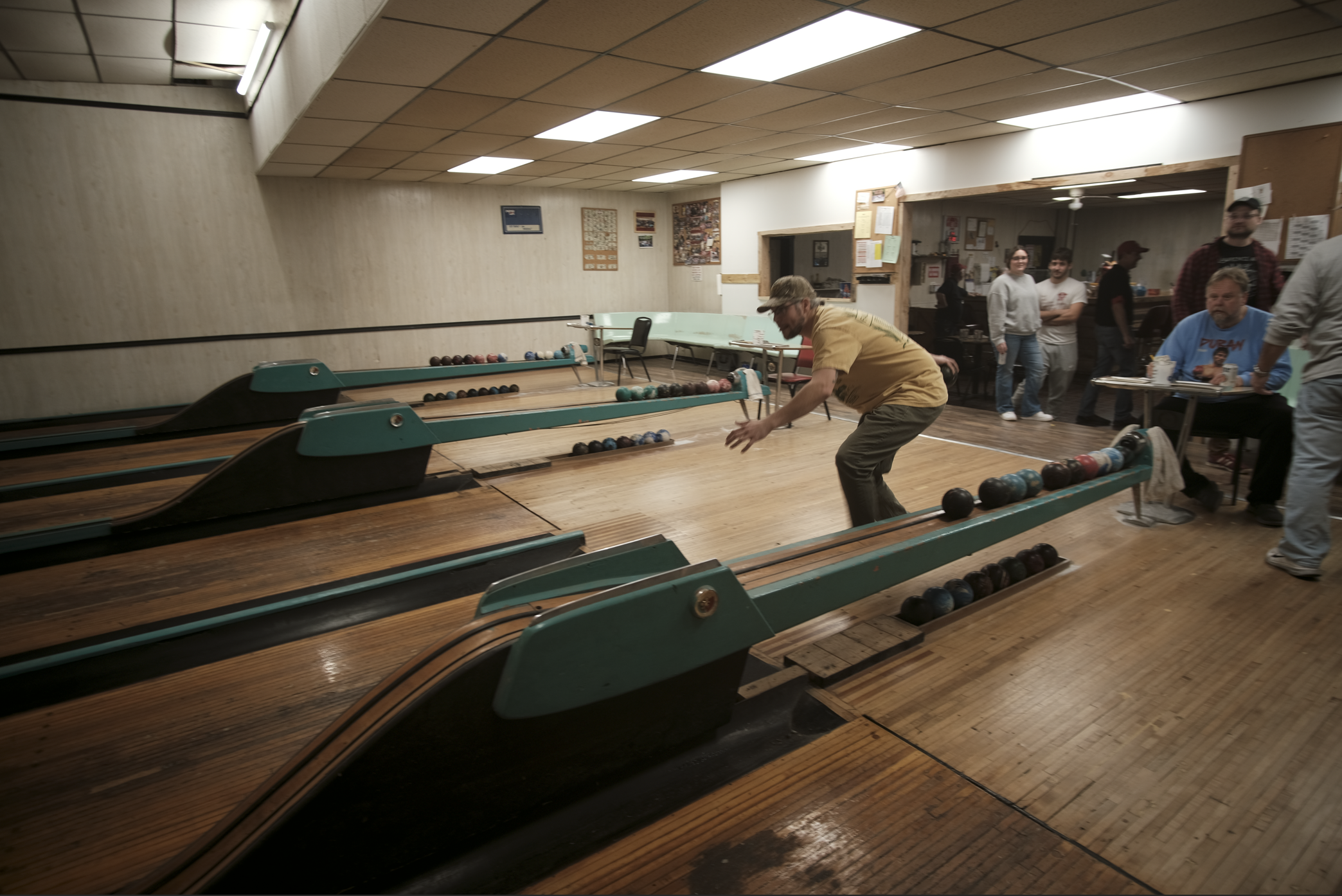
When I was back in Cumberland I tagged along with Casey and Gabe to their duckpin bowling league. This place doesn’t have machines to reset the pins so “Pin Boys” have to hop down and do it by hand (!)

A portrait of my Great Aunt Mary, now 92 years old.
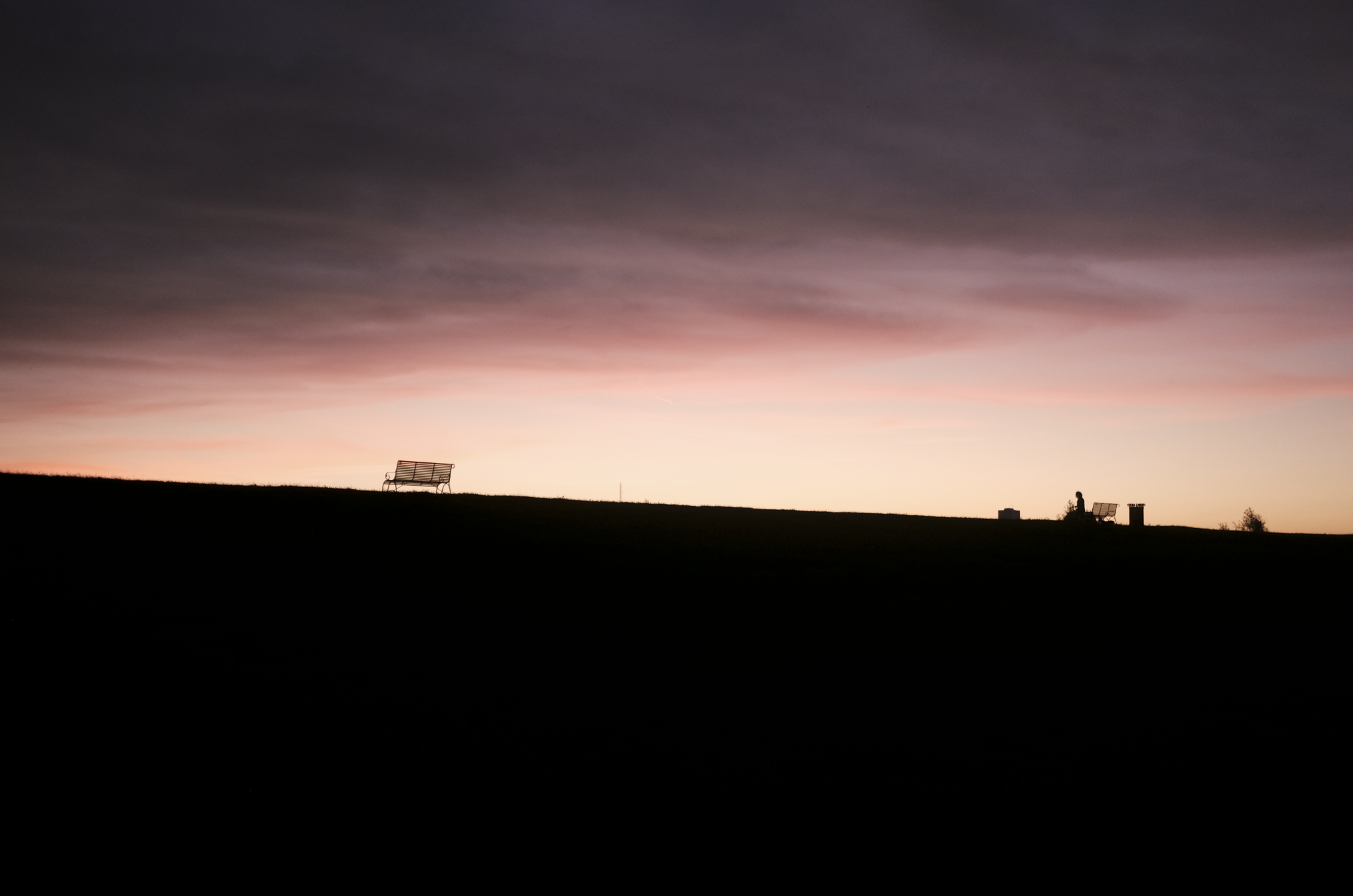
I love the feeling of walking up the crest of the levee to reveal the sunset and I feel like this photo really gets at the feeling, which is sort of hard to describe.
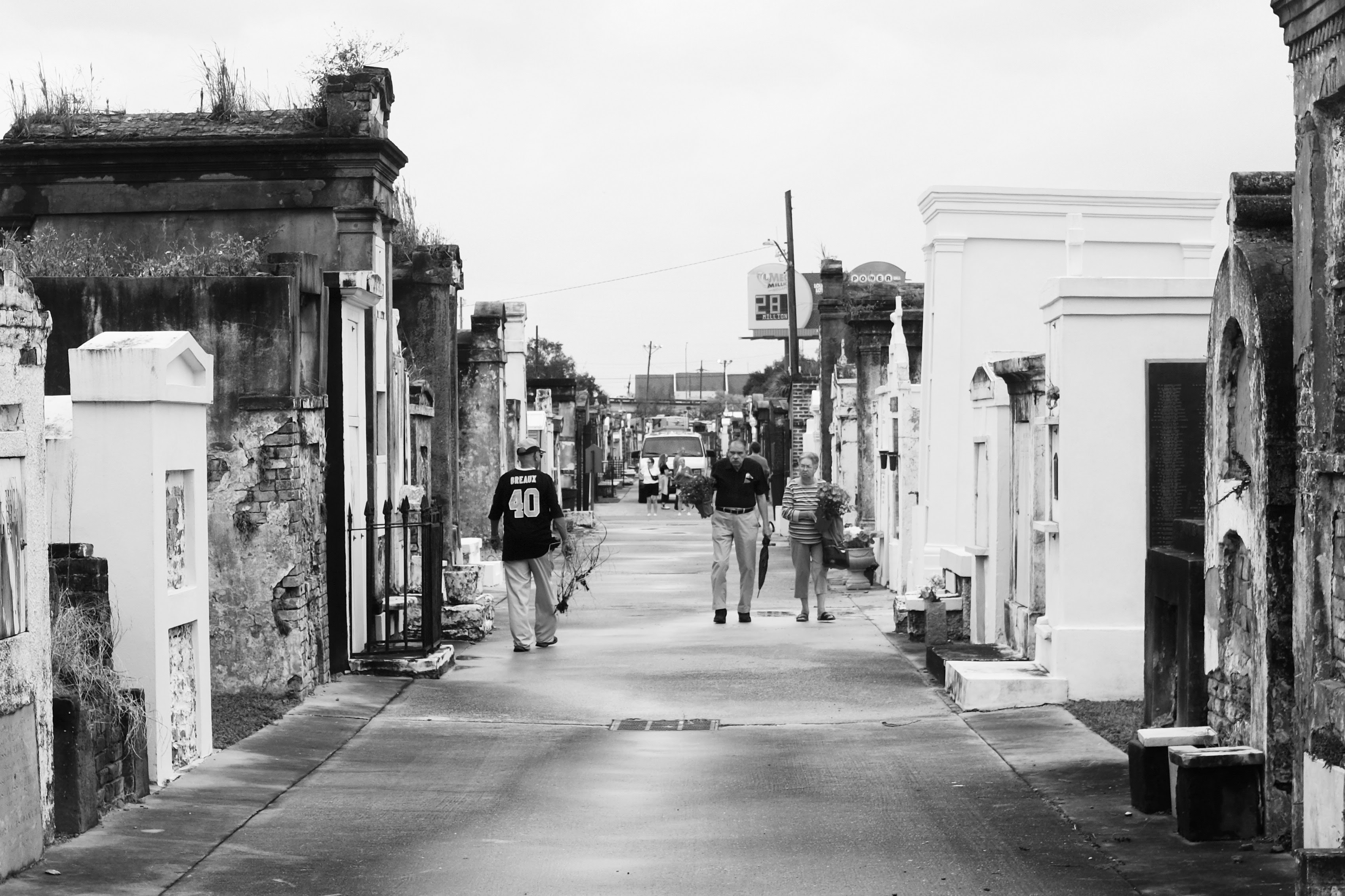
A visitor wearing a Saints jersey to St. Louis Cemetery No. 2 carries an uprooted weed after cleaning a grave as a couple arrives with fresh flowers on All Saints’ Day. I liked this dichotomy (old/ new, dealth/ life) which is further accentuated by the surrounds of the cemetery itself. Ever present is the drone of the I-10 highway overhead, and general urban bricolage creates a jarring backdrop for the historic tombs. (e.g. a billboard for the Mega Millions can be seen in the background).

One of the more overgrown tombs in St. Louis No. 2 on All Saints’ Day.

Speaking of the Liturgical calendar, last night kicked off Carnival, being the start of the Epiphany, or 12th night. This is celebrated in New Orleans with a parade dedicated to Joan of Arc, a charming and wholesome walking parade with lots of Gothic French grab that I attended with my housemates Maggie and Sam and their friend Steven.

My first New Orleans parade, though, was a Second Line which went through my neighborhood a few weeks back!

One more from the Joan of Arc parade last night: this woman was just a spectator but really went all out with her Golden Church Head. I’ve got to start planning my costume for Marti Gras because this city goes all out.
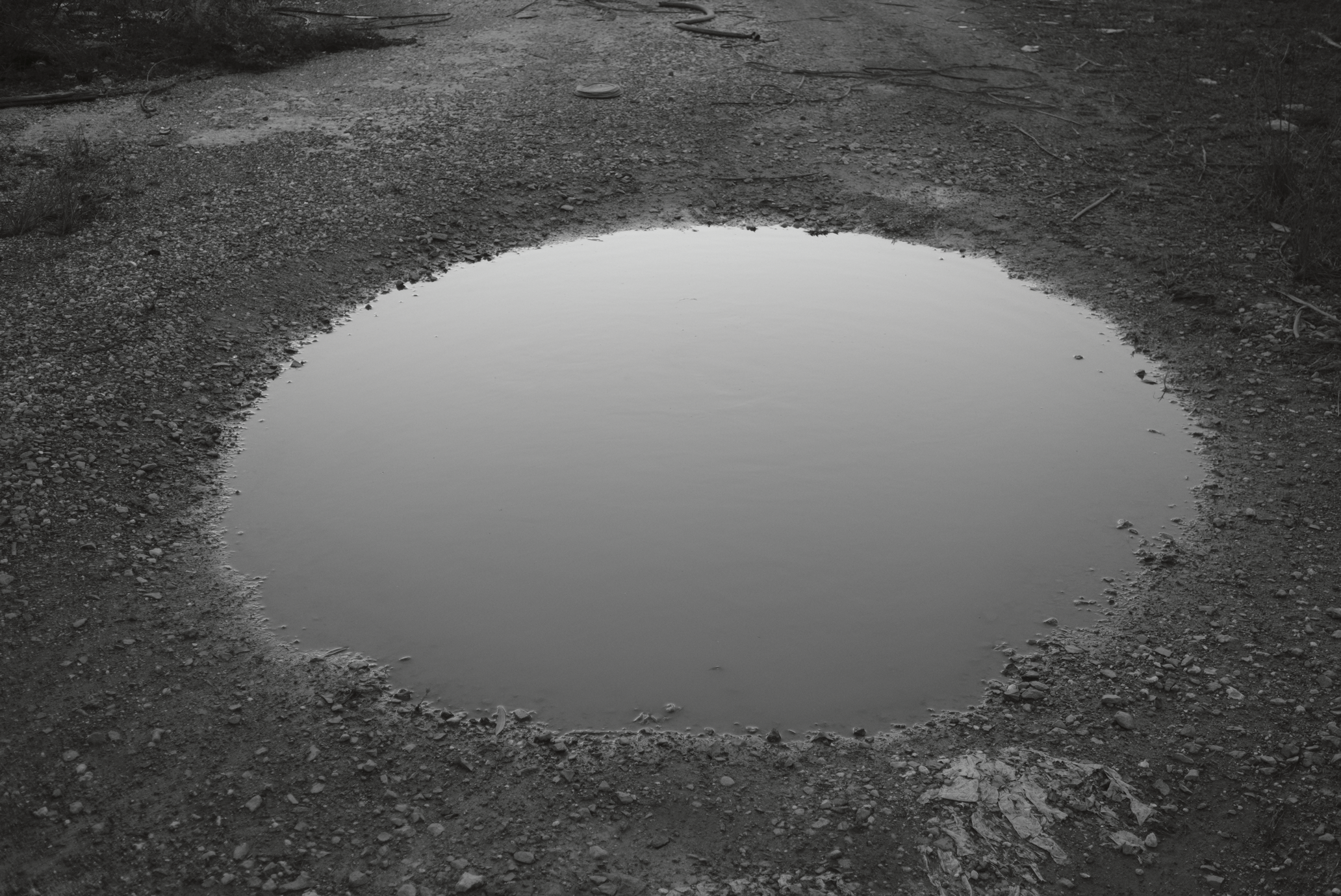
Not much to say here, I just really liked how round this puddle was! Sorry I rambled so much, yet again. Until next time, friends. Stay in touch :)
May the Sun Shine Upon You!
◬
◬